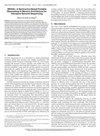RISC-V的可重构AES对抗体系结构与增强的功率侧信道弹性
IF 1.4
3区 计算机科学
Q4 COMPUTER SCIENCE, HARDWARE & ARCHITECTURE
引用次数: 0
摘要
本文介绍了RAESC,一种可重构的高级加密标准(AES)对抗硬件设计,支持AES-128、AES-192和AES-256类型,增强了物联网应用的灵活性和资源效率。该设计结合了一种对策,通过基于输入明文随机化AES类型来防止基于功率的侧信道攻击(PSCA),确保提高安全性。RAESC集成了RV32IM RISC-V处理器,提供简化的操作和增强的系统安全性。性能分析表明,RAESC的自适应加密强度在面积、功率和吞吐量方面实现了平衡权衡,使其成为资源受限、安全敏感的物联网应用的理想选择。针对CPA攻击的电源走线是在专用集成电路(ASIC)上生成的,该设计显著降低了信噪比(SNR),增加了测量披露(MTD),显示出对加密攻击的强大弹性。本文章由计算机程序翻译,如有差异,请以英文原文为准。
RAESC: A Reconfigurable AES Countermeasure Architecture for RISC-V With Enhanced Power Side-Channel Resilience
This paper presents RAESC, a reconfigurable Advanced Encryption Standard (AES) countermeasure hardware design that supports AES-128, AES-192, and AES-256 types, enhancing flexibility and resource efficiency in IoT applications. The design incorporates a countermeasure to protect against Power-based Side Channel Attacks (PSCA) by randomizing the AES type based on input plaintext, ensuring improved security. The RAESC is integrated with an RV32IM RISC-V processor, offering streamlined operation and enhanced system security. Performance analysis shows that RAESC’s adaptive encryption strength achieves a balanced trade-off in area, power, and throughput, making it ideal for resource-constrained, security-sensitive IoT applications. Power traces for CPA attacks are generated on Application Specific Integrated Circuit (ASIC) and the design achieves a notable reduction in the Signal to Noise Ratio (SNR) and an increase in the Measurements to Disclose (MTD), demonstrating strong resilience against cryptographic attacks.
求助全文
通过发布文献求助,成功后即可免费获取论文全文。
去求助
来源期刊

IEEE Computer Architecture Letters
COMPUTER SCIENCE, HARDWARE & ARCHITECTURE-
CiteScore
4.60
自引率
4.30%
发文量
29
期刊介绍:
IEEE Computer Architecture Letters is a rigorously peer-reviewed forum for publishing early, high-impact results in the areas of uni- and multiprocessor computer systems, computer architecture, microarchitecture, workload characterization, performance evaluation and simulation techniques, and power-aware computing. Submissions are welcomed on any topic in computer architecture, especially but not limited to: microprocessor and multiprocessor systems, microarchitecture and ILP processors, workload characterization, performance evaluation and simulation techniques, compiler-hardware and operating system-hardware interactions, interconnect architectures, memory and cache systems, power and thermal issues at the architecture level, I/O architectures and techniques, independent validation of previously published results, analysis of unsuccessful techniques, domain-specific processor architectures (e.g., embedded, graphics, network, etc.), real-time and high-availability architectures, reconfigurable systems.
 求助内容:
求助内容: 应助结果提醒方式:
应助结果提醒方式:


